Hello Trillium growers,
I created this thread for Trillium postings in 2010. Feel free to add to it. I debated whether to place it in "Woodlanders" or in "Bulbs", the later name used in the broadest sense to cover plants having underground storage structures (bulbs, corms, tubers, rhizomes) that we associate with geophytes. I believe the topic belongs here in "Bulbs".
Always the first to bloom is Trillium nivale. The first photo showing mature plants and young flowering-size seedlings taken on March 27th, 2009. The day after that photo, the plant was eaten to the ground by deer.
The second photo shows the same plant, this year flowering a week and a half earlier on 3-19-2010, but much smaller, probably weakened by having all above-ground parts eaten last year.
There's always a bee.
Comments
Re: Trillium 2010
I stopped to see if the wild Trillium nivale were in bloom yet. Just barely beginning here in Minnesota.
Re: Trillium 2010
I have tried several trilliums but not nivale. I see I have to mend that. What kind of habitat is best suited for this gem?
Re: Trillium 2010
Rick, what kind of soil and general habitat do you find Trillium nivale in? Photos I've seen of this species show a species of consistent appearance, have you noticed much variability? When you find it, is it abundant... what size colonies do you find?
It occurred to me that I wasn't familiar with the species range, so here is the USDA map:
http://plants.usda.gov/java/profile?symbol=TRNI2
The species has a "Threatened" status in Minnesota and neighboring Wisconsin, and "Endangered" status in Kentucky and Maryland.
Trond, my plants have been growing well, planted under a Magnolia tree, on a fairly steep slope (although hard to tell from the photos of my plants) in our native rocky silty clay soil amended with some decomposed pine bark mulch. Two more photos of my plants, a couple mature flowering plants, and many 2, 3, & 4 year seedlings from seed that I harvest and scratch in around the "mother" plant. The 2nd photo is a seedling that reached flowering size; about 5 years :o
Re: Trillium 2010
Yes, snow trilliums are rare in MN. I know of only two spots and have been to only one. I knew it grew in a 20 acre area of limestone outcropping, but I had to think like a snow trillium to find it. I went almost straight to it.
This colony grows mostly on a shallow layer (4-6 inches) of humus on a jutting limestone ledge. While the ledge is sun exposed at this time of year, it is completely enclosed in a tree canopy as spring completes. With it grows a few hepatica, mosses. In my opinion, here it is able to compete best with other native flora. There is a bit of a sprinkling of plants below, but the plants are naturally of such small stature that in deeper soils they quickly become engulfed by other, later growing ephemerals. The colony consists of maybe 100 stems, with one quarter of them that bloom. I don't see any variability in this small sampling. But none have such long peduncles/pedicels as in your photo immediately above. The flowers are amazingly long lived (due to the cold weather), lasting a month to month and a half.
Closer inspection this year reveals MN snow trillium do have somewhat red stems, although not to such a degree as yours, Mark. I suspect that if they were grow in a more vigorous fashion, as yours seem to be, they might approach your color quality.
The area is rich with Asarum canadense, Dicentra cucullaria, hepatica acutiloba, Hydrastis sp., Thalictrum thalictroides, Anemone quiquefolia, Uvularia grandiflora, Trillium cernuum, just to name a few of the top of my head. But all those are completely domant still, and grow in the deeper and moister soil below. The only thing growing at this time of year is a bit of aquatic watercress kind of thing, that I have never take the time to try to key.
The other Trillium nivale spot I know of is not cliff like, but a very steep slope (I am told). One of our Chapter members grow it in her garden for more than 20 years, in a run of the mill mix high in humus. She says it hardly increases.
Harvesting trillium seed is a matter requiring constant vigilance, and you have my respect, Mark. Fro the first time I tried with Trillium luteum last season, and just as it ripened, one morning I found every seed stolen. Ants (presumeably) had cut through the side of the bulging capsule and removed every seed.
Re: Trillium 2010
I have no limestone ledge or clay soil on my property but I will create something and try to grow this nice spring flower. I am always trying to grow spring flowering plants!
Re: Trillium 2010
Lots of Trillium coming into bloom after a couple very warm sunny days.
1 T. decumbens in two forms, one from Georgia on the left with lighter leaves and flowers, and the other from Alabama on the right, with darker foliage and flowers.
2. T. grandiflorum - I like the undulate flowers, the white flowers looking picturesque against the dark leaves of Epimedium x youngianum 'Tamabotan'
3. T. grandiflorum 'Multiplex' or Flore Pleno - overdue for lifting and dividing, with over 30 flowering stems this year.
4-5 T. lancifolium from Tennessee, a distinctive species with narrow leaves that angle downwards, and the very narrow maroon flowers. It seeds around, and in the photo you can see a couple younger self-sown plants flowering. Also seen, are T. recurvatum, T. decumbens, and T. reliquum.
6-7 T. reliquum - one of the best for foliage, here again seen in two forms. The first photo taken yesterday, flowers not quite out, the other photo taken this morning, the flowers had opened. I also weeded around the plant, removing Oxalis acetosella (easy) and a tiny invasive weedy veronica (grrrr), now better able to see the baby reliquum. You may also notice foliage of T. nivale close by.
8-9 T. rugelii - just starting to open its shy flowers, another multistemmed clump overdue for division, although it seeds about too.
Re: Trillium 2010
Lancifolium is an interesting species. I like it very much. You sure have some special trilliums, Mark (along with your entire garden!). What is the tree they grow under?
Trillium sessile, an easy grower.
Re: Trillium 2010
Lancifolium is an interesting species. I like it very much. You sure have some special trilliums, Mark (along with your entire garden!). What is the tree they grow under?
Trillium sessile, an easy grower.
T. sessile looks nice... good leaf mottling, one that I do not grow and not familiar with. The tree where my trillium are located is under Magnolia 'Forrest's Pink', once thought to be a M. denudata color form but now considered to be a hybrid with it. It can be magnificent with huge deep purple-rose flowers that are pink-white inside, but in the infamous icestorm of December 2008, it was splintered to a shambles. I heavily pruned it back as part of damage control, and it is coming back fairly well. Most Magnolia trees are good candidates for underplanting scenarios, as they are largely tap-rooted or deep-rooted trees.
Re: Trillium 2010
Nice Trillium collection...none open here yet...maybe in a week or two.
Re: Trillium 2010
A first time bloom on Trillium gracile today, this plant from Texas (thanks Aaron). It's rather neat and trim, looking somewhat like T. foetidissimum, but without a foetid scent.
Trillium vaseyi is a striking species with very large showy red blooms, the uniquely shaped full flowers 8 cm across. Known as Sweet Wakerobin, it is sweet secnted (not detectable on this cold day today).
Now ready to open, the bud teasing me for a couple weeks, the suspense is killing me, a hybrid between T. vaseyi x T. grandiflorum blooming for the first time since I played around with pollen some years back. The scenario is perfect, both parents are in view in my images, with the giant baby in the middle. The foliage on the hybrid looks like like T. grandiflorum, just taller and much bigger, but the large, rather elongate downturned bud is clearly that of T. vaseyi influence. Today, some flower color is peeking through, mostly dark red but some white is evident too! Stay tuned.
T. vaseyi is well known to hybridize with T. rugelii, which I also grow, but I had wondered if it would cross with grandiflorum... evidently so.
Trillium vaseyi distribution map and info:
http://plants.usda.gov/java/profile?symbol=TRVA2
http://utc.usu.edu/factsheets/trillium/trillium_vaseyi/trillium_vaseyi.htm
Image:
http://plants.usda.gov/java/largeImage?imageID=trva2_003_ahp.tif
Trillium vaseyi (Sweet Wakerobin) in Flora of North America:
http://www.efloras.org/florataxon.aspx?flora_id=1&taxon_id=242102017
Re: Trillium 2010
Hurry up! Mark....the suspense is killing us too! Let's see the hybrid's color!
I am imagining mocha or cappucino at least...
Re: Trillium 2010
Interesting! I am waiting too.
If you walk in a woodland, how many spring flowering species of Trillium can you expect to see? I suppose they have different habitats or do some species overlap in the same spot?
Re: Trillium 2010
Down here spring is advancing --a number of the early Trilliums are well above the ground and in the loose whorl stage where you can see down the stem through the leaves to gain an idea of whether individual plants have a flowering bud ---however 'one' plant is further on .
First couple of pics are of 'the' plant ----top --followed by side view.
Thinking i had 2 plants close together i scraped away the soil with a view to maybe moving one of them.
However pic 3 shows both stems are coming from the one rhizome. :o
Pics 4 & 5 ---Individual shots of the respective stems.
A different colour on each stem from the one Trillium plant is something i've never come across before.............
Cheers Dave.
Re: Trillium 2010
Dave, that's so odd, to have two different color flowers with the stems connected to the same rhizome! I wouldn't have believed it had you not shown us the proof. Has it shown different colors in the past? I wonder if the flower color might revert or stay the same, in ensuing years. What species is it?
Re: Trillium 2010
Hello Mark
Not sure if the plant had a couple of stems last year -- if it had been showing the colours as it is currently, i would have attempted to investigate as i am always moving plants around when in growth, so it will be interesting to see what eventuates next season.
I just had to go and have another look at the rhizome late this afternoon --the two stems are definitely coming off the plant ,initially enclosed in a sheath before splitting .
Parentage is unknown ---
T.kurabayashii is the earliest to flower here but this one is well ahead of the others .The leaf pattern is similar to some of my cuneatums.
When the petals open fully i will have a peek at the reproductive setup and sepals and take a few meaurements as an aid to it's ID ,although i find it difficult sometimes to be 100% certain as when you grow kurabayashii, angustipetalum and even cuneatum from the USA east coast all together you can end up with all sorts of combinations.
Cheers dave.
Re: Trillium 2010
Parentage is unknown ---
T.kurabayashii is the earliest to flower here but this one is well ahead of the others .The leaf pattern is similar to some of my cuneatums.
When the petals open fully i will have a peek at the reproductive setup and sepals and take a few meaurements as an aid to it's ID ,although i find it difficult sometimes to be 100% certain as when you grow kurabayashii, angustipetalum and even cuneatum from the USA east coast all together you can end up with all sorts of combinations.Cheers dave.
Hmmm, I don't have first hand experience with any of those three species (kurabayashii, angustipetalum, cuneatum), but did receive seed of T. cuneatum this year. And as you suggest, there might be hybrids. Regardless, beautiful leaf patterning, and we'll all want to know how it flowers next year, to see if it is still playing tricks :)
Re: Trillium 2010
Another early Trillium out today .
A lovely coloured T. angustipetalum :-* -- the flowers will darken yet.
You can see it has a small deformed 4th petal which in my experience will not appear next season.
Interestingly quite a number of my T.s are 'blind' this year--no doubt still recovering from being weakened by a fungal disease of last year--i sprayed early this month with Octave just as the plants were 'moving' and thankfully there is no sign of any problem. :) :)
However in saying that ,there are still many in bud ,so hopefully i can post more pics during the next week or so.
Re: Trillium 2010
Trillium nivale grown in a trough with limestone .
I'm down to a couple of flowering plants ,so have stopped dividing the clump for garden visitors --- there are however a number of seedlings present.
Re: Trillium 2010
As it is starting to feel like fall here, it's great to see signs of spring!
Re: Trillium 2010
I get the idea from wild stands of Trillium nivale, that the species sends out stolons. In some places, the ground is carpeted with the plant. When you divide them, Dave, do you find this to be the case?
Re: Trillium 2010
As it is starting to feel like fall here, it's great to see signs of spring!
Didn't feel like spring here today Lori --wet all day with a very cold south easterly off the sea and a high of 8C :)
I get the idea from wild stands of Trillium nivale, that the species sends out stolons. In some places, the ground is carpeted with the plant. When you divide them, Dave, do you find this to be the case?
Have never noticed stolons Rick--however you raise a good point because when i cut around the edge ,with a knife ,of a patch ,(maybe that is a better word),and lift ,there is not the strong clumping i observe with some other Trilliums that i grow (like chloros.) :-\
Re: Trillium 2010
I haven't disturbed my clumps of Trillium nivale, but it looks as if they seed around readily. They are found in parts of Indiana, but not around here (central Indiana). The ones doing best in my garden are not those from Southern Indiana but rather some from Illinois.

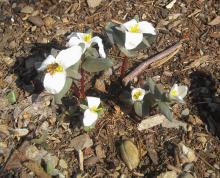
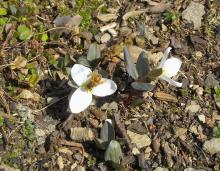
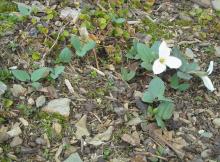
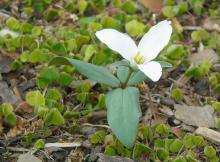
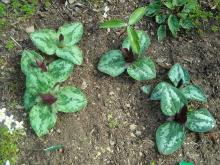
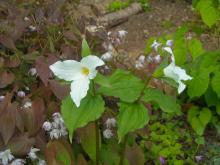
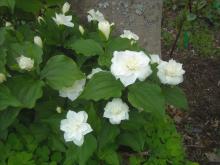
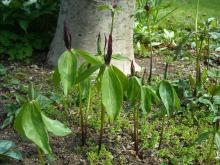
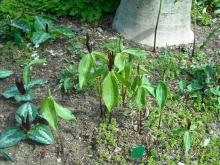
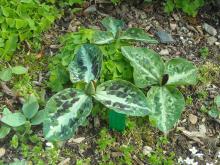
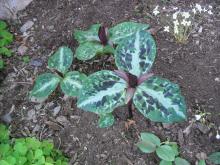
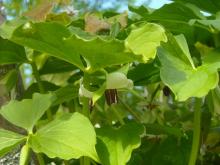
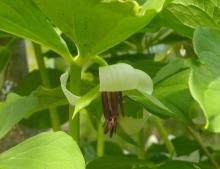
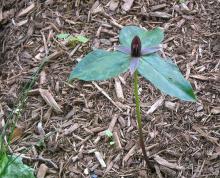
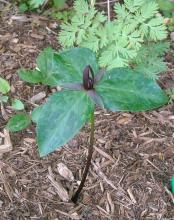

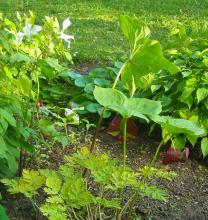
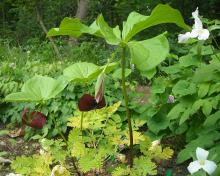
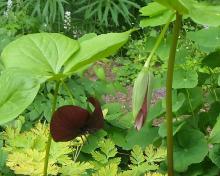
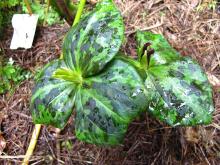

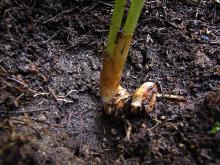
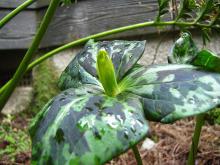
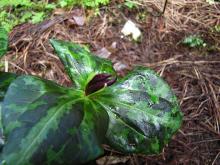
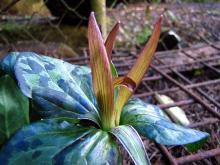
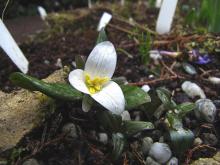
I've gotta try to get this one. I've seen it in several gardens and it is so attractive even for its glaucous foliage. Our problem here with early bloomers is late frost destroying them..I even have problems with grandiflorum getting blasted by our typical May frosts.